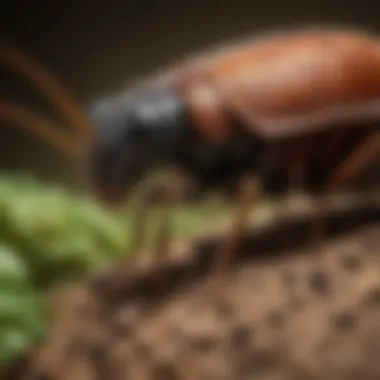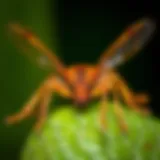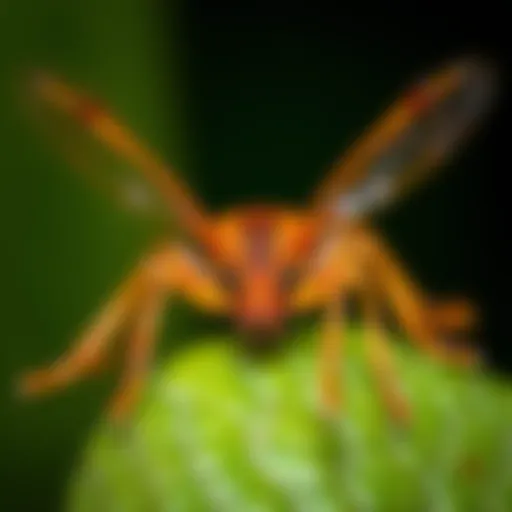Atascosa Pest Control: Essential Strategies and Tips


Intro
Pest control is a significant concern for many homeowners and renters in Atascosa. From termites eating away at wooden structures to ants marching in uninvited, understanding the ins and outs of pest management is essential. Not just for keeping homes comfortable, but also for protecting investments. This guide endeavors to provide a broad perspective on pest control practices suited specifically for the Atascosa region, helping you navigate through a variety of strategies to deal with pests effectively.
Pest Identification
Detailed Descriptions of Common Pests
Identifying the pests that invade your home is the first step in controlling them. In Atascosa, several common culprits tend to show up. Here are a few of them:
- Termites: Often called "silent destroyers," termites can chew through wood, flooring, and even wallpaper without anyone noticing until it's too late. They are usually found in moist areas or structures made of wood.
- Ants: These little critters come in various types, such as carpenter ants and fire ants, each posing unique problems. Carpenter ants, in particular, can weaken wooden structures by tunneling through them.
- Cockroaches: Common in warmer climates, roaches not only are a nuisance but also pose health risks as they can carry diseases. They often hide in dark, damp places and come out at night.
- Rodents: Mice and rats are more than just a gross sight. They reproduce quickly and can damage food supplies as well as household items.
Signs and Symptoms of Infestations
Knowing how to look for signs of pests can save you a significant headache.
- For termites, signs include mud tubes on your walls and hollow-sounding wood when you knock on it.
- Ant infestations can often be seen through the trails they leave behind, usually marching towards a food source.
- Cockroaches typically leave droppings behind, which resemble coffee grounds or black pepper.
- Rodents often leave droppings, nesting material, and even footprints, especially in dusty areas.
"Early detection is key in pest control; ignorance may very well cost a pretty penny in damages."
Prevention Strategies
Home Maintenance Tips for Pest Prevention
Preventing pests before they become a problem is always preferable. Here are some tips:
- Seal Cracks and Openings: Small gaps in your home's exterior can be an open door for all sorts of pests. Caulking and sealing gaps in windows, doors, and foundations can dramatically reduce entry points.
- Keep Food Stored Properly: Storing food in airtight containers keeps them safe from pests. Never leave pet food out overnight.
- Maintain Cleanliness: Regular cleaning routines, especially in the kitchen, will help eliminate crumbs and spills that attract pests.
- Manage Moisture Levels: Termites and other pests love damp conditions. Fix any leaks and ensure proper drainage around your home.
Natural Deterrents and Barriers
Sometimes, simple household items can act as great deterrents against pests:
- Diatomaceous Earth: Sprinkle this around the perimeter of your home. It’s safe for humans and pets but deadly for insects.
- Essential Oils: Oils like peppermint or tea tree oil can be effective deterrents for ants and spiders when mixed with water and sprayed in problem areas.
Treatment Options
Overview of Chemical vs. Natural Treatments
When pests invade, deciding on the treatment can be a daunting task. Chemical treatments are often quicker but can come with health concerns, especially for pets and children. On the other hand, natural treatments tend to work more subtly but are usually safer.
Step-by-Step Guides for DIY Treatments
If you’re inclined to go the DIY route, here are some common treatments:
- For ants: Mix equal parts vinegar and water in a spray bottle. Spray areas where ants are spotted and wipe clean.
- For cockroaches: Combine baking soda with sugar at a ratio of 1:1, sprinkle it in areas where they are seen. They are attracted to the sugar, and the baking soda will do the rest.
- For termites: If you spot an infestation, you can create a barrier with orange oil or use nematodes, tiny worms that eat termites.
Following the right strategies and knowing how to identify pests can ensure that your home remains pest-free. This knowledge, along with professional help when needed, can make a world of difference in comfort and security at home.
Understanding Pest Control
Understanding pest control is more than just foraying into the realm of extermination or the use of chemicals. It’s about grasping the dynamics between pests and our living spaces. In Atascosa, where a variety of pest species can interrupt daily life, knowing how to effectively manage these unwelcome guests is a vital skill for homeowners and renters alike.
Defining Pest Control
Pest control refers to the methods and practices employed to manage or eliminate pests that threaten homes, properties, or even agricultural endeavors. This definition encompasses a range of strategies including prevention, monitoring, and control techniques. The term "pest" itself can be broadly defined; it includes anything from insects like termites and ants to larger mammals such as rodents. In essence, pest control seeks to balance the ecosystem in such a way that human interests are protected without completely wiping out other species (which can also have important roles).
The approaches to pest control can be classified into three main categories:
- Preventive Measures: These involve routine actions aimed at keeping pests at bay. Simple steps such as keeping food stored properly, sealing cracks in walls, and maintaining clean environments can thwart many common pests before they even have a chance to become a nuisance.
- Mechanical Control: This category includes traps and physical barriers that can help keep pests from entering spaces. Solutions like installing screens on windows or using rodent traps fall under this umbrella.
- Chemical Control: While this is often the most discussed form of pest control, it’s important to approach it judiciously, ensuring that any chemicals used are necessary and applied safely. Knowledge of the specific pests at hand can guide the selection of the right treatment methods, fostering effective management efforts.
The Importance of Pest Control
Understanding pest control is crucial not only for maintaining a comfortable living space but also for safeguarding health and property values.
- Health Risks: Many pests can carry diseases or cause allergic reactions. For instance, rodents are known to transmit illnesses like hantavirus, while cockroaches may trigger asthma in sensitive individuals.
- Property Damage: Pests such as termites can cause substantial harm to structures, often going unnoticed until significant damage has occurred. This makes early identification and intervention paramount.
- Quality of Life: The presence of pests can lead to stress and discomfort at home. Knowing how to address these issues helps restore peace of mind and ensures a pleasurable living experience.
"An ounce of prevention is worth a pound of cure." This old adage rings particularly true in pest control. By understanding the basics, individuals can take lasting steps to protect their homes and well-being from infesting invaders.
In Atascosa, where local conditions may be conducive to specific types of pests, being informed and proactive is fundamental. Whether it’s through preventive actions or knowing when to involve professional pest management, the importance of understanding pest control cannot be overstated.
Types of Pests Common to Atascosa
When it comes to managing pests in Atascosa, understanding the types of pests that homeowners may encounter is crucial. Knowledge about pests goes beyond recognizing a creepy crawly; it deals with prevention, identification, and ultimately, the safeguarding of your home. The implications of allowing pests to thrive are extensive, including property damage, health risks, and emotional distress. By identifying common pests, homeowners can tailor their pest control strategies to effectively fight back.
Identifying Common Pests


Pests are like uninvited guests who simply refuse to leave. In Atascosa, some of the more common culprits include termites, ants, rodents, and cockroaches. Each of these pests exhibits distinct characteristics that help in their identification:
- Termites: Tiny and usually pale, these wood-eating pests are more seen than heard, munching away at structural beams and furniture silently.
- Ants: Depending on the species, ants may vary in color and size. They often travel in trails, so seeing one means there's likely a whole colony nearby.
- Rodents: Mice and rats may leave behind droppings and gnaw marks. Their nighttime foraging habits often lead them to kitchen areas or sealed food storage containers.
- Cockroaches: Commonly brown or black, these pests can scuttle away with surprising speed and are known to hide in dark, warm places.
Recognizing the specific signs of these pests can save homeowners not just headaches, but also a lot of money down the line.
Termites: The Silent Destroyers
Termites are often dubbed as "silent destroyers" for a good reason. They can cause extensive damage to homes before their presence becomes known to the average homeowner.
In Atascosa, the most prevalent species is the Eastern Subterranean termite, which thrives on moist environments and wood-based structures. Homeowners should look out for:
- Mud tubes: These are small tunnels made of soil, created by termites seeking food sources.
- Bubbling paint: Infestations can lead to moisture, creating an appearance similar to water damage on painted surfaces.
- Wood damage: Termite damage may resemble hollow wood, with a crunchy texture often felt when tapped.
Proactive identification of termites can lead to timely intervention, which is critical as the cost of repairs can escalate rapidly once damage is done.
Ants and Rodents: Understanding Their Behavior
Ants and rodents aren't just nuisances—they can become a significant concern depending on their population dynamics and behavior.
Ants form colonies, and their behavior can drastically impact pest control decisions. For instance, certain species are attracted to sweets or proteins, while others may find their way indoors simply seeking shelter. Understanding their food preferences helps determine the best ways to bait and trap these pests.
Rodents, like mice and rats, exhibit infuriatingly clever behavior. They are known to squeeze through small openings, so eliminating entry points is paramount. Watching for signs such as scratching noises at night or chew marks on food packaging can signal a rodent problem. These pests can also carry diseases, which adds health risks to their presence.
In summary, knowing the typical pests in Atascosa and understanding their habits can make all the difference in effectively managing them. Homeowners can protect their sanctuary by being vigilant and responding quickly to pest sightings.
Identifying Pests: Signs and Symptoms
Identifying pests early on is crucial for effective management and prevention strategies. Homeowners and renters in Atascosa often find themselves battling pest issues that can escalate into larger problems if not addressed promptly. Understanding the signs and symptoms of infestations not only saves money in potential damage repairs but also offers peace of mind.
By honing in on the characteristics and behaviors of different pests, residents can catch infestations before they wreak havoc on their living spaces.
Visual Indicators of Infestation
Visual clues serve as the first line of defense when it comes to spotting pests. For instance, one might notice droppings in obscure corners or strange marks akin to smudges on walls. These signs aren’t just incidental; they indicate which pests are invading your domain. An astute observer might spot tiny wood shavings near baseboards or furniture, signaling the presence of termites.
Additionally, some pests leave distinguishable trails. Ants, for example, tend to march in a line, creating a trail of pheromones that others follow. Failing to identify these visual hints could mean that a homeowner misses the opportunity to intervene before greater damage is done.
Some notable visual indicators to watch for include:
- Bites or Stings on household members: This can indicate the presence of bedbugs or fleas.
- Small holes in food packaging: A sure sign of pantry pests like weevils.
- Nesting materials: This can mean rodents, particularly if you find shredded paper or fabric.
It's vital to remain vigilant and regularly inspect areas that are often neglected, such as attics, basements, and behind appliances.
Structural Damage and Other Alerts
Structural damage often acts as a red flag that something is amiss. Homeowners may find themselves facing costs that can run into thousands of dollars if pests like termites or carpenter ants go unchecked.
Termites, for instance, weaken wood, and their damage can sometimes go unnoticed until it's too late. Signs of structural damage can include:
- Sagging floors: This might indicate serious structural issues likely caused by termites.
- Cracked or crumbling walls: Rodent activity can lead to significant damage here as they gnaw at drywall and insulation.
- Doors and windows that stick or are hard to close: These issues can signal a shift in the home’s structure due to pest infestations.
Moreover, homeowners should not overlook the importance of scent as an indicator of pests. For instance, a musty odor could point to mold from moisture related to rodent droppings.
"Ignoring the signs can turn a minor pest problem into a full-blown infestation, resulting in costly repairs and a stressful living environment."
Effective Pest Prevention Techniques
Preventing pest infestations is not just a good practice; it’s an essential part of maintaining a healthy home environment. Effective pest prevention techniques serve as a first line of defense for homeowners in Atascosa, where certain pests can become a real nuisance. By implementing simple yet effective strategies, one can save not only money but also time and peace of mind.
Home Maintenance Best Practices
Keeping your home in tip-top shape goes a long way in pest prevention. Regular maintenance helps in identifying potential issues before they escalate. Here are some vital practices:
- Seal Cracks and Openings: Check for gaps around windows, doors, and the foundation. Cracks can be an open invitation for bugs to sneak in. Using caulk or weatherstripping can make a huge difference.
- Regular Cleaning: A tidy home makes it less appealing for pests. Vacuum regularly, especially in hard-to-reach areas, and don’t forget to take out the trash promptly. Leaving food crumbs around is like rolling out the red carpet for ants.
- Manage Moisture: Many pests thrive in damp environments. Fix leaks and ensure any areas prone to humidity are well-ventilated. This includes areas like bathrooms and basements, where a bit of mold can signal danger.
- Proper Food Storage: Keep food in sealed containers. Open cupboards can attract pests simply looking for a snack. Just like us, pests have preferred dining experiences, and a sealed bag of flour is a five-star meal.
Natural Pest Deterrents
In the quest for pest prevention, many homeowners are turning to natural solutions that are both effective and eco-friendly. These deterrents not only help in keeping unwanted guests at bay but also do so without the harsh chemicals commonly found in conventional treatments. Here are several options:
- Essential Oils: Scents like peppermint and tea tree oil can repel ants and spiders. Just mix a couple of drops with water and spray around entry points. It’s a quick fix that also leaves your home smelling fresh.
- Diatomaceous Earth: This natural powder can be sprinkled in areas prone to pests. It works by dehydrating insects that come in contact with it. Think of it as the bouncer of your home, keeping the riffraff out without a fuss.
- Vinegar: Utilizing a 50/50 mix of vinegar and water can work wonders. Not only does it clean surfaces, but it also acts as a natural repellent for many pests. Plus, you can use it in your cleaning routine!
- Plants as Deterrents: Some plants like lavender and marigold can act as natural repellents. Plus, they do add charm to your garden. Choosing plants that naturally deter pests can beautify the space while providing protection.
"An ounce of prevention is worth a pound of cure." – This saying holds particularly true for pest control. By integrating these prevention techniques into your routine, you set the stage for a home that is not just livable but also enjoyable.
The methods highlighted are not exhaustive but demonstrate the importance of smart practices in pest control. With a mix of daily routines and the right products, you're setting yourself up for success in pest management.
Professional Pest Control Services


Choosing professional pest control services can be a game-changer for homeowners struggling with pest issues in Atascosa. Relying solely on DIY methods may work for minor infestations, but when the problem escalates, enlisting the expertise of a pest control professional can save both time and money in the long run. Pest control specialists bring a wealth of knowledge and access to industrial-grade treatments that are more effective than many over-the-counter solutions.
There are crucial reasons to consider the expertise of professional services. First and foremost, these specialists are trained to identify not just the obvious pests, but also the ones that hide out of sight. This includes understanding the life cycles and behaviors of various pests, which allows for a tailored approach that can address the roots of the infestation, not just the symptoms. They evaluate the situation holistically by examining potential entry points, environmental factors, and conducive conditions that allow pests to thrive.
Moreover, professional pest control ensures safety for both residents and pets. Many treatments available to the public can pose risks if not applied correctly. Experts utilize methods that are effective yet safe, reducing the chances of exposure to harmful chemicals.
Finally, an ongoing pest control program can offer continuous protection from recurring infestations, turning an initial reactive measure into a proactive approach.
"Investing in professional pest control can be the key to a pest-free home, turning frustration into peace of mind."
When to Seek Help
Recognizing when to call in the professionals can sometimes feel like a guessing game. One clear signal is if you notice a significant increase in pest activity. For example, if a few ants have turned into a full-blown army marching across your kitchen counter, it's time to seek help.
Also, if your attempts at pest control haven’t yielded positive results, don’t hesitate to ask for professional assistance. It’s better to confront the issue head-on than let it fester. Structural damage is another indicator for serious concern. If you find holes in the walls or wood shavings near furniture, this is a cry for help that requires immediate action. Ignoring such signs can be like playing with fire.
Evaluating Pest Control Companies
Finding the right pest control company can seem daunting, but some fundamental tips can simplify the process. Start by seeking recommendations from friends, neighbors, or local online platforms. Reviews can provide useful insights into the experiences of others in your area. Look carefully into the company’s credentials. Are they licensed and insured? This is a must; otherwise, you might open yourself up to liability should things go sideways.
Not all pest control companies are created equal. Some may specialize in certain pests, while others offer a broad range of services. Verify what kind of treatments they use—are they eco-friendly, or do they rely on harsher chemicals? If you have kids or pets, understanding these methods becomes essential.
Furthermore, transparency in pricing is vital. A reputable company will outline its fees upfront without hidden costs lurking in the fine print. You might also want to inquire about guarantees for their work; companies that stand by their service tend to instill more confidence.
In the end, taking the time to thoroughly evaluate your options can spell the difference between a pest control nightmare and a hassle-free solution.
Chemical vs. Natural Pest Solutions
In the ever-evolving landscape of pest control, one hotly debated topic is the choice between chemical and natural solutions. Homeowners in Atascosa often grapple with weighing the effectiveness of these methods against health and environmental concerns. Whether dealing with a burgeoning termite problem or an aggressive ant colony, understanding the pros and cons of both approaches is crucial for making informed decisions.
Understanding Chemical Treatments
Chemical treatments have been a mainstay in pest control for decades. These methods typically involve the application of synthetic compounds designed to kill or deter pests. While effective, the very potency of these chemicals can raise eyebrows. Some key points to consider include:
- Speed of Action: Chemical treatments often yield immediate results, eliminating pests almost on contact. This can be especially reassuring when facing a sudden infestation.
- Variety of Options: The market is flooded with chemical solutions that target specific pests, making it easier to choose an effective remedy.
- Health Risks: Despite their effectiveness, chemical treatments sometimes carry toxicity risks. Proper safety precautions must be undertaken to protect both residents and pets. Misapplication can lead to unintended consequences, so following instructions closely is paramount.
"In pest control, timing is just as important as method. Choose wisely, and you'll reap the benefits."
It's also essential to understand that some pesticides can have a detrimental effect on beneficial insects like bees, which play a critical role in local ecosystems. Furthermore, prolonged exposure to certain chemical substances can lead to resistance among pest populations, diminishing the long-term effectiveness of these treatments.
The Case for Organic Solutions
On the flip side, organic solutions have recently gained momentum, with many Atascosa residents turning to these more sustainable options. The growing concern for the environment and human health has inspired a movement towards eco-friendly pest control practices. Notable advantages of organic approaches include:
- Health and Safety: Organic solutions are generally regarded as safer for children and pets. Common methods include using diatomaceous earth or essential oils like peppermint and rosemary. These ingredients repel or kill pests while posing minimal harm to humans.
- Environmental Impact: By choosing organic methods, homeowners contribute to a healthier ecosystem. Organic solutions usually break down more quickly in the environment, reducing the chances of harmful residues affecting soil and waterways.
- Long-Term Solutions: Many organic pest control methods focus on habitat modification and prevention strategies, creating an unfriendly environment for pests rather than simply killing them. This approach often leads to longer-lasting results.
Both methods come with their own unique sets of benefits and drawbacks. It’s wise for individuals to evaluate their specific pest problems, understand the implications of their choices, and make the most informed decision for their households in Atascosa. Balancing efficacy with health and environmental considerations will ultimately lead to more thoughtful pest management.
Long-term Pest Management Strategies
Long-term pest management strategies are essential for homeowners in Atascosa. Pest control should never be just a one-off effort; neglecting post-treatment can lead to pests returning quicker than a raccoon raiding your trash can. This section discusses the strategies that form the backbone of enduring pest management, focusing on integrating prevention and treatment while employing community-based approaches.
Integrating Prevention and Treatment
A successful pest control plan hinges on the relationship between prevention and treatment. It's like the yin and yang of pest management: without one, the other struggles to thrive. Being proactive means not waiting for an infestation to surge before acting. For example, sealing cracks around windows and doors, using screens, and maintaining sanitation in and around your home can deter pests before they even think of moving in.
Preventative measures also include routine inspections. Engaging a professional on a semi-annual basis to check for signs of pest activity can save homeowners a heap of trouble. If treatment is necessary, there are several options to consider:
- Integrated Pest Management (IPM): This holistic approach combines biological, cultural, physical, and chemical tools in a way that minimizes economic, health, and environmental risks.
- Regular Monitoring: Install traps and other monitoring devices to catch pests before they multiply.
- Tailored Solutions: Recognize that each pest requires a different approach; tailored solutions lead to better results.
Integrating these strategies not only combats current infestations but also contributes to overall home health. After all, nobody wants to share their living space with unwelcome critters.
Community-Based Approaches
When looking for a solution, one mustn't overlook the power of community. In Atascosa, neighbors can come together to combat pest issues more effectively than any lone wolf could hope to achieve. Community-based approaches offer several benefits:
- Shared Knowledge: Residents share their experiences, strategies, and even referrals to trusted pest control professionals, turning the neighborhood into a support network.
- Bulk Purchasing Power: When multiple households band together for pest control services or organic treatments, it can lead to discounts and cost savings.
- Awareness Campaigns: Community events, workshops, and online platforms can raise awareness about specific pests, common signs of infestations, and effective prevention methods.
"Many hands make light work"—this idiom rings especially true in pest management. By working collectively, communities can create significant barriers against pest invasions. When pests hit, everyone suffers, so it's wise to confront the issue as a unit instead of battling alone.
The Role of Education in Pest Control
In the realm of pest control, education stands as a cornerstone, serving as a shield that empowers individuals to tackle infestations effectively. Being informed about pests, their behaviors, and control methods can make all the difference between a household grappling with an invasion or one that effectively manages and prevents unwanted visitors. Education not only eliminates fear but also fosters a sense of responsibility in handling pest issues.
Pests like termites or rodents can become a homeowner's worst nightmare if left unchecked. However, armed with knowledge, individuals can take proactive steps. For instance, understanding the life cycle of a termite can assist in spotting an infestation early, potentially saving thousands in damage.
Indeed, education equips one with benefits that flutter far beyond the walls of a residence. The community benefits when residents are knowledgeable about common pest problems, leading to collective action that resonates against local nuisances. In essence, informed homeowners contribute to a healthier living environment for everyone.


Staying Informed About Local Pests
Awareness about local pests—what they look like, when they’re most active, and how they behave—is crucial in Atascosa. Common culprits in the area may include ants, roaches, and the infamous termite. Knowing the enemy is half the battle. By understanding the habits of these pests, families can take preventive measures tailored to their unique circumstances.
- Know the Seasons: Certain pests are more prevalent during specific times of the year. For instance, termites often swarm in the spring, making early detection and prevention strategies essential.
- Identify Signs of Infestation: Familiarizing oneself with the signs—like droppings, gnaw marks, or even mud tubes in the case of termites—will aid in early identification. Locating pests before they wreak havoc can save time and money.
- Community Communication: Connecting with neighbors about pest sightings or control methods can provide valuable insights. Whether it's sharing information via social media groups or community meetings, collective knowledge creates a strong defense against pests.
“An ounce of prevention is worth a pound of cure.” - Benjamin Franklin
Participating in Training and Workshops
Engaging in pest control training and workshops can be an eye-opener for both individuals and homeowners. These workshops often provide hands-on experience and direct interaction with experts, which can greatly enhance one's understanding of effective pest control practices.
Joining local training sessions offers several advantages:
- Hands-on Learning: Workshops often include demonstrations that allow participants to see pest behavior and control methods in action. This practical approach can reinforce learning in a way that reading or watching videos cannot.
- Networking Opportunities: Meeting others facing similar pest challenges can lead to valuable connections. Sharing experiences and strategies can create a support network that enhances community knowledge.
- Access to Resources: Participants often receive materials or toolkits that can assist with pest management. These resources might include guides on identifying pests or tips on employing safe pesticide use.
- Up-to-Date Information: Pest control techniques are always evolving. Training sessions can provide insights into the latest methods, particularly when it comes to eco-friendly solutions that are gaining popularity.
Debunking Common Pest Control Myths
Understanding pest control isn’t just about knowing how to get rid of unwanted guests in your home; it’s also about shedding light on misconceptions that can lead to ineffective methods and wasted efforts. Pests can wreak havoc if left unchecked, but relying on myths can sometimes make matters worse. Therefore, debunking common pest control myths is crucial to empower homeowners and renters alike with concrete information, ultimately leading to healthier living conditions.
Separating Fact from Fiction
When it comes to pest control, many myths float around household gatherings like uninvited flies. One prevalent myth is that garlic or essential oils will keep pests at bay. While some scents might act as mild deterrents, they usually don’t solve a real infestation. Let’s dig deeper into a few widely-held beliefs:
- Myth: Bugs prefer dirty homes.
- Myth: All pesticides are harmful.
- Myth: You can solve infestations without professional help.
- Fact: Pests can invade any space, regardless of cleanliness. They’re mainly searching for food, shelter, or moisture. A neat home might just be easier to inspect for issues.
- Fact: Not all pest control products are created equal. Some are designed specifically for indoor use and may contain safer ingredients for humans and pets.
- Fact: While DIY methods can be effective for minor issues, larger infestations often require specialized knowledge and tools that only professionals possess.
Understanding the facts helps steer clear of misguided actions that can exacerbate pest problems.
Understanding the Science Behind Pest Control
The effectiveness of pest control measures often hinges on understanding the behavior and biology of pests. Pest management isn't merely about elimination; it's about managing the ecosystem effectively. Here are a few scientific principles involved in pest control:
- Behavioral Patterns: Different pests have different habits. For example, termites operate silently and year-round, while beetles might be seasonal. Knowledge of these patterns can enhance preventative strategies.
- Life Cycles: Each pest species goes through distinct life stages – egg, larvae, adult. Targeting specific stages might be more effective. In the case of cockroaches, using targeted treatments during their reproductive phase can significantly reduce their populations.
- Environmental Impact: A thorough understanding of how pest control methods might affect local ecosystems is essential for environmentally friendly practices. Many modern pest control solutions focus on integrated pest management (IPM), combining biological, physical, and chemical tools.
In summary, uprooting myths about pest control lays the groundwork for informed decisions and results in better pest management. By marrying scientific understanding with practical application, homeowners can adopt sensible strategies that protect their homes without resorting to ineffective or harmful methods.
Resources for Pest Control in Atascosa
When it comes to managing unwanted critters in your home, having the right resources at hand is not just important; it's essential. This section delves into the various avenues available to homeowners in Atascosa, aiming to empower readers with knowledge and support they can access. From local organizations that know the ins and outs of regional pests to online platforms where tips and community advice flourish, these resources form a vital backbone in the fight against infestations.
Local Government and Organizations
Local government initiatives often provide significant support in pest control. For individuals facing pest issues, understanding what their local government offers can be a game changer. The city of Atascosa has a dedicated pest control program that focuses on educating residents about common local pests, and the most effective ways to deal with them.
Among essential services provided, you might find:
- Educational Workshops: Regularly organized workshops educate homeowners about pest identification and prevention methods. Attending one of these can give local residents the upper hand when it comes to spotting issues before they escalate.
- Community Awareness Campaigns: These programs aim to inform citizens about seasonal pests like termites and rodents and to help promote community-wide pest management strategies.
- Hotline Services: Often, there’s a hotline where people can report severe infestations or seek advice on managing pests. This immediate access to resources can help avoid costly damage to homes.
Knowing how to access these services can save headaches down the road and ensure you’re not battling pest issues alone.
Online Platforms and Support
In today’s world, online resources play an integral role in pest control. From forums where you can share experiences to websites with comprehensive guides on specific pests, the internet is a treasure trove of information that anyone can tap into.
Consider these online platforms:
- Reddit: Subreddits focused on pest management allow users to interact and exchange firsthand experiences. Questions about nuisances can be posed, and you might get responses from those who have tackled similar problems.
- Facebook Groups: Local residents often create community groups to share advice and solutions related to pest control. These can act as support networks where advice flows both ways.
- YouTube Videos: Sometimes, seeing is believing. Online tutorials related to pest control provide visual guidance on how to identify issues or apply remedies at home. Watching experts dismantle a rodent trap could make the difference in how effective you are at doing it yourself.
These platforms enable connections and support that extend beyond mere articles, promoting active engagement in pest management throughout the community.
Ending
The importance of this article lies in its comprehensive approach to pest control within Atascosa. When we step back and look at the multifaceted nature of pest management, it's clear that each aspect contributes significantly to maintaining a healthy living environment. Homeowners and renters alike must grasp the connections between pest identification, prevention techniques, and effective treatment options to combat infestations head-on.
Summarizing Key Takeaways
In summarizing the key points discussed throughout the article, several critical insights surface:
- Understanding Your Local Environment: The uniqueness of Atascosa's climate impacts the types of pests prevalent in homes. Being aware of these can lead to better prevention strategies.
- Identifying Pests Early: Recognizing visual signs of infestations early can make a marked difference in how infestations are managed. This not only saves time but often reduces costs associated with pest control.
- Employing Combined Strategies: Balancing chemical treatments with natural solutions fosters a safer home. This dual approach not only minimizes chemical exposure but also promotes a healthier ecosystem.
- Staying Educated: Continuously updating one's knowledge on pest control through workshops and community resources is invaluable. The more informed homeowners are, the more prepared they become against potential threats.
Encouraging Proactive Pest Management
Encouraging proactive pest management involves cultivating habits that deter infestations before they start. Here are a few strategies to consider:
- Regular Home Inspections: Schedule biannual checks around your property to spot any signs of pests or vulnerabilities.
- Landscaping Considerations: Be mindful of how trees and shrubbery are placed. Keeping a distance from your home acts as a buffer against invasive pests.
- Educating Family Members: Ensuring that everyone in the household understands basic pest management can foster a collective responsibility towards maintaining a pest-free environment.
- Utilizing Resources: Make good use of local pest control services, workshops, and online platforms. Joining community discussions on platforms like Reddit can provide valuable shared experiences and advice.
These considerations not only safeguard your home but also foster a sense of community resilience against pest-related challenges.



